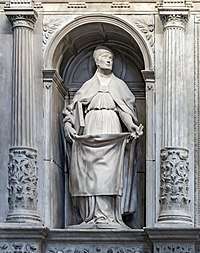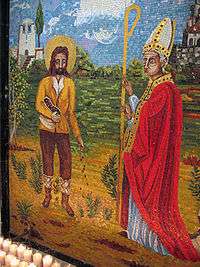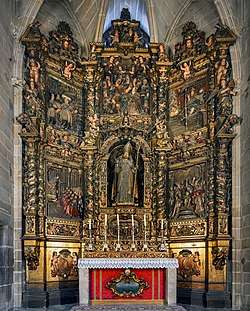Severus of Barcelona
Severus of Barcelona (Catalan: Sant Sever, Spanish: San Severo) is venerated as a saint by the Catholic and Eastern Orthodox churches. His legend states that he was a bishop of Barcelona and was martyred during the persecution of Christians by Diocletian in AD 304. Details concerning his life and death are uncertain and of questionable historicity, and his Acta actually date from around the sixth century.[1]
Saint Severus of Barcelona | |
|---|---|
 Statue of Saint Severus Barcelona cathedral | |
| Born | Barcelona |
| Died | ~304 |
| Venerated in | Roman Catholic Church, Eastern Orthodox Church |
| Feast | 6 November |
| Attributes | bishop with a nail or nails driven into his head |
| Patronage | Barcelona |
Legend

According to his legend, he was born in Barcelona to a noble family and received a good education. In a hymn associated with his office, it is stated explicitly that he was a citizen of Barcelona.[1] A variant of the legend status that he was a humble weaver upon whose head a dove landed. The people of the city saw this as a sign and elected him bishop.[2]
He was chosen bishop of Barcelona around 290. During the persecution of Diocletian, Severus fled to Castrum Octavianum (Sant Cugat), where he encountered a fellow Christian, named Emeterius (Catalan: Sant Medir, Medí, Spanish: San Medir, Medín),[3] sowing beans in the field. Severus instructed the man that if the soldiers sent to kill him asked the farmer where he had gone, to tell them that he had passed this way.[4]
A miracle made the beans he was cultivating sprout immediately after Severus left. When the soldiers came across Emeterius and asked him if he had seen the bishop, Emeterius replied that he had and it was when he was sowing the fields. Angry at this lie and believing that Emeterius was mocking them, the soldiers arrested the man and took him to Castrum Octavianum.
Severus meanwhile appeared to the soldiers, along with four other priests from Barcelona who had fled with him. The four priests were flogged and then killed with a sword. Emeterius also suffered this fate. Severus was beaten with a cat o' nine tails, and nails were driven into his head. The soldiers left the bishop on the ground. However, he did not die and when Christians from Barcelona heard that Severus was still alive, they attempted to revive him. However, he died in the arms of one of them.
Veneration

Some sources state that Severus' relics were buried at Sant Cugat, where a church dedicated to him was built. A monastery, the one that stands there today, was built alongside the church. When that church was destroyed, Severus’ relics were translated to the monastery. In the fifteenth century, some of the relics were taken to Barcelona, to which were attributed various miracles, including curing King Martin I of gangrene in his leg.[1] Saint Peter Nolasco and Ferdinand I were also devoted to his cult. The Baroque church of Sant Sever, near the Cathedral of Barcelona, was dedicated to him.
The hermitage of Sant Medir, near Sant Cugat, is dedicated to Emeterius. A separate festival dedicated to Emeterius is celebrated in the first week of March.[5]
| Wikimedia Commons has media related to Severus of Barcelona. |
Notes
- San Severo
- 6 de noviembre Archived 2007-10-29 at the Wayback Machine
- Not to be confused with another Saint Emeterius, who was martyred with Celedonius
- Rincones_del_mundo Archived 2008-06-02 at the Wayback Machine
- San Medir - España - Viajeros.com
External links
- Severus of Barcelona
- (in Spanish) San Severus
- (in Spanish) San Severo